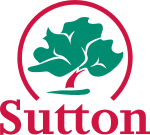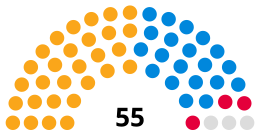Sutton London Borough Council
Sutton London Borough Council | |
|---|---|
 Coat of arms | |
 Council logo | |
| Type | |
| Type | |
| Leadership | |
Mayor of Sutton | Colin Stears since 18 May 2020 |
Leader of the Council | Ruth Dombey, Liberal Democrat since 21 May 2012 |
Chief executive | Helen Bailey since 25 February 2019 |
| Structure | |
| Seats | 54 councillors |
 | |
Political groups |
|
| Elections | |
| Plurality-at-large | |
Last election | 5 May 2022 |
Next election | 7 May 2026 |
| Meeting place | |
 | |
| Sutton Civic Offices | |
| Website | |
| www | |
Sutton London Borough Council is the local authority for the London Borough of Sutton in Greater London, England. It is a London borough council, one of 32 in the United Kingdom capital of London. Sutton is divided into 18 wards, each electing three councillors. Following the May 2018 council election, Sutton London Borough Council comprises 33 Liberal Democrat councillors, 18 Conservative Party councillors, and 3 Independent councillors, a decrease of the Liberal Democrat majority.[1] The council was created by the London Government Act 1963 and replaced three local authorities: Beddington and Wallington Borough Council, Sutton and Cheam Borough Council and Carshalton Urban District Council.
History[edit]

There have previously been a number of local authorities responsible for the Sutton area. The current local authority was first elected in 1964, a year before formally coming into its powers and prior to the creation of the London Borough of Sutton on 1 April 1965. Sutton replaced Beddington and Wallington Borough Council, Sutton and Cheam Borough Council and Carshalton Urban District Council.[2]
It was envisaged that through the London Government Act 1963 Sutton as a London local authority would share power with the Greater London Council. The split of powers and functions meant that the Greater London Council was responsible for "wide area" services such as fire, ambulance, flood prevention, and refuse disposal; with the local authorities responsible for "personal" services such as social care, libraries, cemeteries and refuse collection. As an outer London borough council it has been an education authority since 1965. This arrangement lasted until 1986 when Sutton London Borough Council gained responsibility for some services that had been provided by the Greater London Council, such as waste disposal. Since 2000 the Greater London Authority has taken some responsibility for highways and planning control from the council, but within the English local government system the council remains a "most purpose" authority in terms of the available range of powers and functions.[3]
Powers and functions[edit]
The local authority derives its powers and functions from the London Government Act 1963 and subsequent legislation, and has the powers and functions of a London borough council. It sets council tax and as a billing authority also collects precepts for Greater London Authority functions and business rates.[4] It sets planning policies which complement Greater London Authority and national policies, and decides on almost all planning applications accordingly. It is a local education authority and is also responsible for council housing, social services, libraries, waste collection and disposal, traffic, and most roads and environmental health.[5]
Policies[edit]
The council was a pilot authority for the Big Society programme.[6]
Summary results of elections[edit]
Since 1964 political control of the council has been held by the following parties:
| Party in control | Years | |
|---|---|---|
| Conservative | 1964–1986 | |
| No overall control | 1986–1990 | |
| Liberal Democrats | 1990–present | |
| Year | Liberal Democrats | Conservative | Labour | Residents Association /Independent |
Notes |
|---|---|---|---|---|---|
| 1964[7] | 0 | 30 | 17 | 4 | |
| 1968[8] | 0 | 41 | 7 | 3 | |
| 1971[9] | 0 | 25 | 21 | 5 | |
| 1974[10] | 6 | 28 | 13 | 4 | |
| 1978[11] | 2 | 47 | 7 | 0 | Boundary changes increased number of seats by five |
| 1982[12] | 3 | 46 | 7 | 0 | |
| 1986[13] | 28 | 21 | 7 | 0 | |
| 1990[14] | 32 | 18 | 6 | 0 | |
| 1994[15] | 47 | 4 | 5 | 0 | |
| 1998[16] | 46 | 5 | 5 | 0 | |
| 2002[17] | 43 | 8 | 3 | 0 | Boundary changes reduced the number of seats by two |
| 2006[18] | 32 | 22 | 0 | 0 | |
| 2010[citation needed] | 43 | 11 | 0 | 0 | |
| 2014[19] | 45 | 9 | 0 | 0 | |
| 2018[19][20] | 33 | 18 | 0 | 3 | |
| 2022[21] | 29 | 20 | 3 | 3 | |
References[edit]
- ^ "Election Results May 2018". Sutton London Borough Council.
- ^ Youngs, Frederic (1979). Guide to the Local Administrative Units of England. Vol. I: Southern England. London: Royal Historical Society. ISBN 0-901050-67-9.
- ^ Leach, Steve (1998). Local Government Reorganisation: The Review and its Aftermath. Routledge. p. 107. ISBN 978-0714648590.
- ^ "Council Tax and Business Rates Billing Authorities". Council Tax Rates. Retrieved 8 April 2020.
- ^ "Local Plan Responses – within and outside London". Mayor of London. Retrieved 9 April 2020.
- ^ "Sutton Council". sutton.gov.uk.
- ^ "Election Results" (PDF). 7 May 1964. Retrieved 26 April 2020.
- ^ "Election Results" (PDF). 9 May 1968. Retrieved 26 April 2020.
- ^ "Election Results" (PDF). 13 May 1971. Retrieved 26 April 2020.
- ^ "Election Results" (PDF). 2 May 1974. Retrieved 26 April 2020.
- ^ "Election Results" (PDF). 4 May 1978. Retrieved 26 April 2020.
- ^ "Election Results" (PDF). 6 May 1982. Retrieved 26 April 2020.
- ^ "Election Results" (PDF). 8 May 1986. Retrieved 26 April 2020.
- ^ "Election Results" (PDF). 3 May 1990. Retrieved 26 April 2020.
- ^ "Election Results" (PDF). 5 May 1994. Retrieved 26 April 2020.
- ^ "Election Results" (PDF). 7 May 1998. Retrieved 26 April 2020.
- ^ "Local Elections Archive Project - 2002 - Sutton". www.andrewteale.me.uk.
- ^ "Local Elections Archive Project - 2006 - Sutton". www.andrewteale.me.uk.
- ^ a b "Brent". BBC News Online. Retrieved 19 February 2015.
- ^ "Sutton London Borough Council". BBC News.
- ^ "London Borough Sutton election result 2022". BBC News. Retrieved 16 January 2023.
